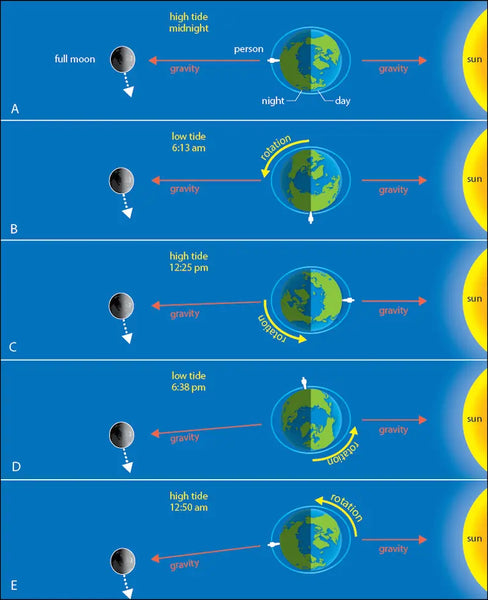Understanding Tides: The Science Behind the Rise and Fall of Our Oceans
Share
Tides are a fascinating natural phenomenon primarily caused by the gravitational interactions between the Earth, the Moon, and to a lesser extent, the Sun. Here's a detailed explanation of how tides work:

Gravitational Forces and Tidal Bulges
The tides are primarily driven by the gravitational pull of the Moon on Earth's oceans. The Moon's gravity causes the water on the side of Earth closest to the Moon to be pulled towards it, creating a bulge. Interestingly, a second bulge forms on the opposite side of the Earth due to the inertia of the water. This is because the gravitational pull is weaker on the far side of the Earth, allowing the water to "lag" behind, forming another bulge. These two bulges represent high tides.

Earth's Rotation and Tidal Cycles
As the Earth rotates, different areas of the planet pass through these bulges, experiencing high tides. Conversely, when a region is between the bulges, it experiences low tides. This rotation results in most coastal areas experiencing two high tides and two low tides each day.
Role of the Sun
While the Moon plays the dominant role in creating tides, the Sun also contributes to tidal forces. Although the Sun is much larger, it is also much farther away, so its gravitational effect on tides is less than that of the Moon. However, when the Sun, Moon, and Earth align during full and new moons, their gravitational forces combine to create higher high tides and lower low tides, known as spring tides. Conversely, when the Sun and Moon are at right angles relative to the Earth, they produce neap tides, which are less extreme.
Misconceptions About Tides
A common misconception is that the tides are simply the water moving in and out. In reality, the Earth rotates within these stationary tidal bulges. Therefore, the water level changes we observe are due to the Earth's rotation through these bulges rather than the water itself moving across the ocean.
Understanding tides involves recognizing the dynamic interplay of gravitational forces and Earth's rotation, which together create the rhythmic rise and fall of sea levels along coastlines worldwide.
Read More 👈
Celebrating Earth Day: A Surfer's Perspective on Sustainability and Ocean Conservation
How to Grow Fresh Air Indoors using Common Plants
Why We Need to Stop Eating Parrot Fish?
Why It’s Important to Always Respect and Listen to Our Lifeguards
